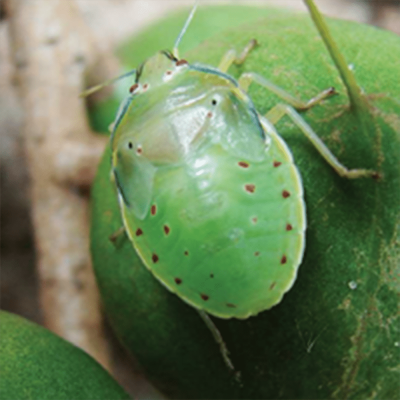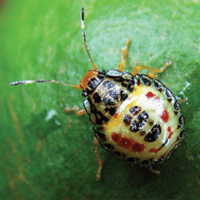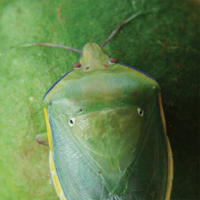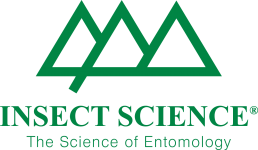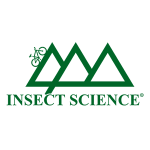Host plants
Apart from macadamia, avocado and pecan, the bug reportedly also feeds on tassel berry, Antidesma venosum (Phyllanthaceae) and kei apple, Dovyalis caffra (Flacourtiaceae).
Damage
Two types of damage symptoms occur. Feeding during the early development stages of the nuts, when cell division and cell enlargement is actively taking place, results in deep necrotic lesions in the kernels, whereas nuts damaged after cell division and cell enlargement are usually oily, with a glazed, almost semi-transparent appearance. White feeding marks are visible when epidermal layers covering feeding sites are removed. The mouthparts of the stink bugs may also infect the kernel with a range of opportunistic saprophytic fungi. Affected nuts are often completely rancid and unfit for human consumption.
The two-spotted stink bug mostly feeds about once per day. After the initial period of early nut abortion (nine weeks post anthesis) nuts normally no longer abort. About 80% of all shield bugs found on macadamias in South Africa are Bathycoelia distincta, which is regarded as the most prolific pentatomid bug on this crop.
Life history
Eggs are usually deposited in clusters of 14 and are clearly visible on the main stems of mature macadamia trees from December to April. The eggs hatch after about seven days and the first instar nymphs tend to cluster together on the empty eggshells; if disturbed their survival is significantly compromised. From the second instar, the mouthparts are sufficiently long to penetrate the combined thickness of the hulls and shells of most macadamia cultivars.
Hot spots develop in orchards because the ability of the flightless nymphs to disperse is limited. Adults are low density feeders and towards the end of January, when adults are most numerous, up to three insects per tree may be encountered in badly managed orchards.
The life cycle of the bugs is synchronised with the phenology of the nuts; no egg laying and hence no immature stages are normally encountered during the first nine weeks after flowering. Nuts are most susceptible to damage after premature nut drop and before the shells have fully hardened about six weeks later. Although shell hardening limits damage, B distincta can nevertheless penetrate the shell and damage the kernel up to harvest. In the absence of fruit during August and September, few bugs are present and they only migrate into orchards after flowering during October to December and early January with three well defined nymphal peaks during November/December, January/February and April-July. The entire life cycle lasts between 49-70 days, depending on temperature.
Natural enemies
Parasitic wasps that have been recorded from South Africa include two unidentified species of Trissolcus (Family Scelionidae) and a species of Pediobuis (Eulophidae), all of which are egg parasitoids. Adult parasitoids include four species of tachinid flies of which Cylindromyia eronis Curran and Bogosia bequaerti Villeneuve are indigenous, whereas Trichopoda giacomellii (Blanchard) and T. pennipes (Fabricuis) were imported from the biological control of the vegetable stink bug, Nezara viridula.
Management
The low tolerance for stink bug damage on macadamia necessitates regular spraying of orchards with a range of synthetic pyrethroids, often resulting in the emergence of secondary pests. To combat this, alternative control measures have been investigated, including the use of trap crops, planting of pest resistant cultivars, tree size manipulation to improve chemical spray cover and mechanical and physical practices such as the manual destruction of stink bug eggs. However, to date none of these methods have been very effective in the control of the two-spotted and other stink bugs on macadamia.

